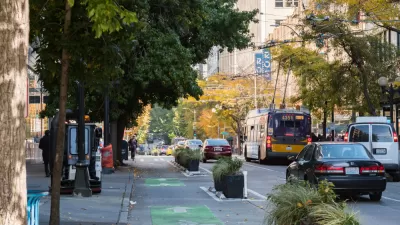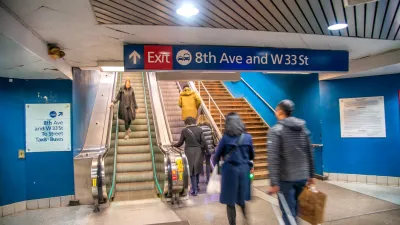Conventional traffic safety programs emphasize ways that individuals can help reduce their risk, but new research indicates that safety depends largely on community planning decisions that affect how and how much people drive.
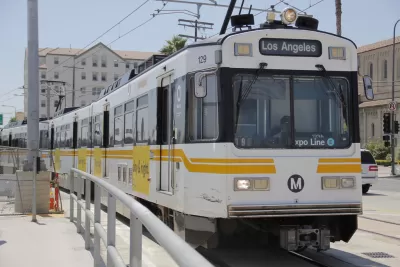
I hope that my article, "A New Transit Safety Narrative," recently published in the Journal of Public Transportation, will change the way people think about transportation risks and reform traffic safety programs. The study shows that public transit is, overall, a relatively safe (low crash risk) and secure (low crime risk) travel mode, and that per capita crash casualty rate tend to decline as transit ridership increases in a community. Transit improvements and transit-oriented development should therefore be recognized as traffic safety strategies.
These findings have been discussed in various blogs, including StreetBlog’s "Here’s How Much Safer Transit Is Compared to Driving," and Clean Technica’s "The Truth Of How Safe Transit Is Compared To Driving." Both include the graph below which compares crash rates per passenger-mile of transit, automobiles, and trucks. This generated considerable reader debate about the merits of automobile versus transit travel. Unfortunately, this misses the key point of my article.

My research emphasizes that traffic safety is significantly affected by community planning decisions, such as land use policies and roadway design that affect the amount that people drive, so risks should be measured per capita rather than per mile or kilometer of travel.
To understand this point, look at the graph below, which shows show the relationships between per capita annual transit ridership and traffic fatality rates for youth (15-25 years old) and total populations for various U.S. cities. Although youths have about twice the traffic fatality rate as the overall average, both rates decline significantly with increased transit travel: cities where residents take more than 50 transit trips have about half the average traffic fatality rate as cities where residents average fewer than 20 annual transit trips. The statistical relationship between transit ridership and traffic safety is particularly strong for youths.
Youth and Total Traffic Fatality Rates
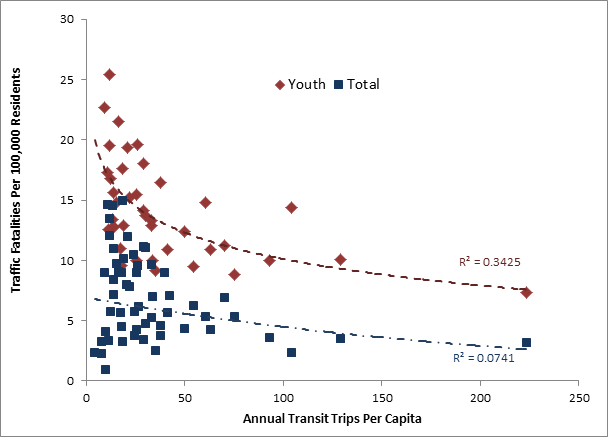
Both youth (15-25 years old) and total traffic fatality rated decline significantly with increased transit travel. The statistical relationship between transit ridership and traffic safety is particularly strong for youths, suggesting that many young people are willing to reduce their higher-risk driving if given suitable alternatives.
This and other research discussed in my article indicate a strong negative relationship between transit ridership and crash fatality rates. This relationship is particularly strong for youths, indicating that many young people want to reduce their driving, but can only do so if given suitable alternatives. This suggests that traffic safety programs which attempt to discourage high risk driving, such as graduated licensing, senior drivers' skill testing, and anti-drunk-driving campaigns, will be much more successful if higher-risk travelers, such as youths, seniors, and drunks, have good alternatives to driving.
These reductions in higher-risk driving benefit everybody, including low-risk drivers, who face less chance of being involved in a crash caused by other drivers' errors. The figure below summarizes the various ways that transit improvements and transit-oriented development increase traffic safety. This helps explain why apparently small increases in public transit ridership can provide large traffic safety benefits.
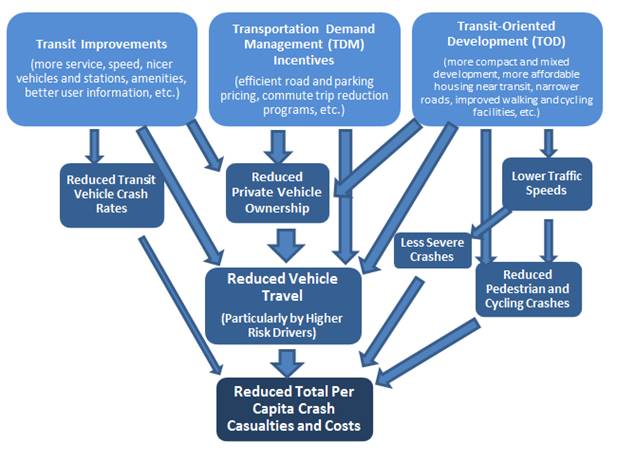
Pro-transit can increase traffic safety in various ways. Some transit improvements reduce transit user risks. Shifting travel from automobile to transit tends to reduce risk to the people who shift and, by reducing total vehicle travel, to reduce risks to other road users. Vehicle travel reductions can also provide significant co-benefits, including reduced traffic and parking congestion, consumer savings, energy conservation, emission reductions, and improved mobility for non-drivers.
Unfortunately, few traffic safety programs recognize these factors. They give little or no consideration to transportation policy reforms that improve travel options and smart growth policies that help reduce per capita vehicle travel, although these can provide large crash reductions in addition to other economic, social and environmental benefits. We need a new narrative concerning public transit safety and the role it should play in traffic safety programs.

Planetizen Federal Action Tracker
A weekly monitor of how Trump’s orders and actions are impacting planners and planning in America.

Maui's Vacation Rental Debate Turns Ugly
Verbal attacks, misinformation campaigns and fistfights plague a high-stakes debate to convert thousands of vacation rentals into long-term housing.

Restaurant Patios Were a Pandemic Win — Why Were They so Hard to Keep?
Social distancing requirements and changes in travel patterns prompted cities to pilot new uses for street and sidewalk space. Then it got complicated.

In California Battle of Housing vs. Environment, Housing Just Won
A new state law significantly limits the power of CEQA, an environmental review law that served as a powerful tool for blocking new development.

Boulder Eliminates Parking Minimums Citywide
Officials estimate the cost of building a single underground parking space at up to $100,000.

Orange County, Florida Adopts Largest US “Sprawl Repair” Code
The ‘Orange Code’ seeks to rectify decades of sprawl-inducing, car-oriented development.
Urban Design for Planners 1: Software Tools
This six-course series explores essential urban design concepts using open source software and equips planners with the tools they need to participate fully in the urban design process.
Planning for Universal Design
Learn the tools for implementing Universal Design in planning regulations.
Heyer Gruel & Associates PA
JM Goldson LLC
Custer County Colorado
City of Camden Redevelopment Agency
City of Astoria
Transportation Research & Education Center (TREC) at Portland State University
Jefferson Parish Government
Camden Redevelopment Agency
City of Claremont



























